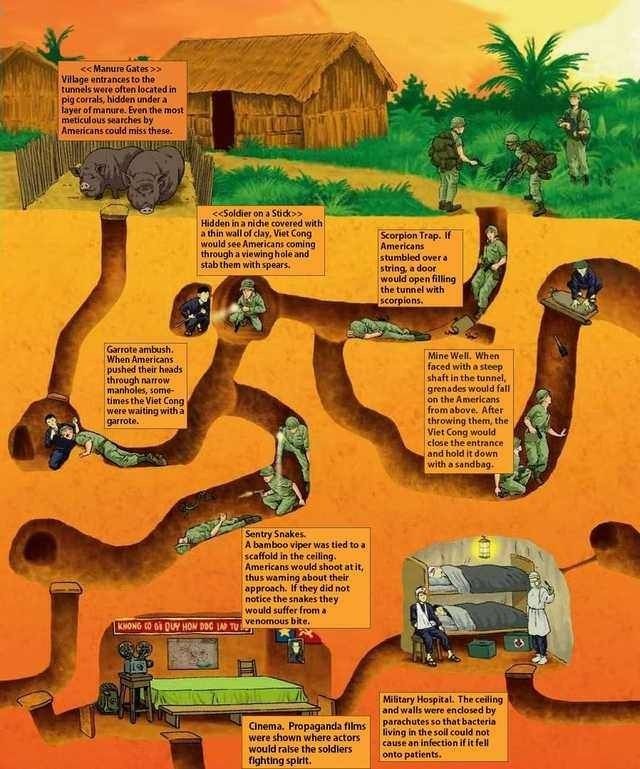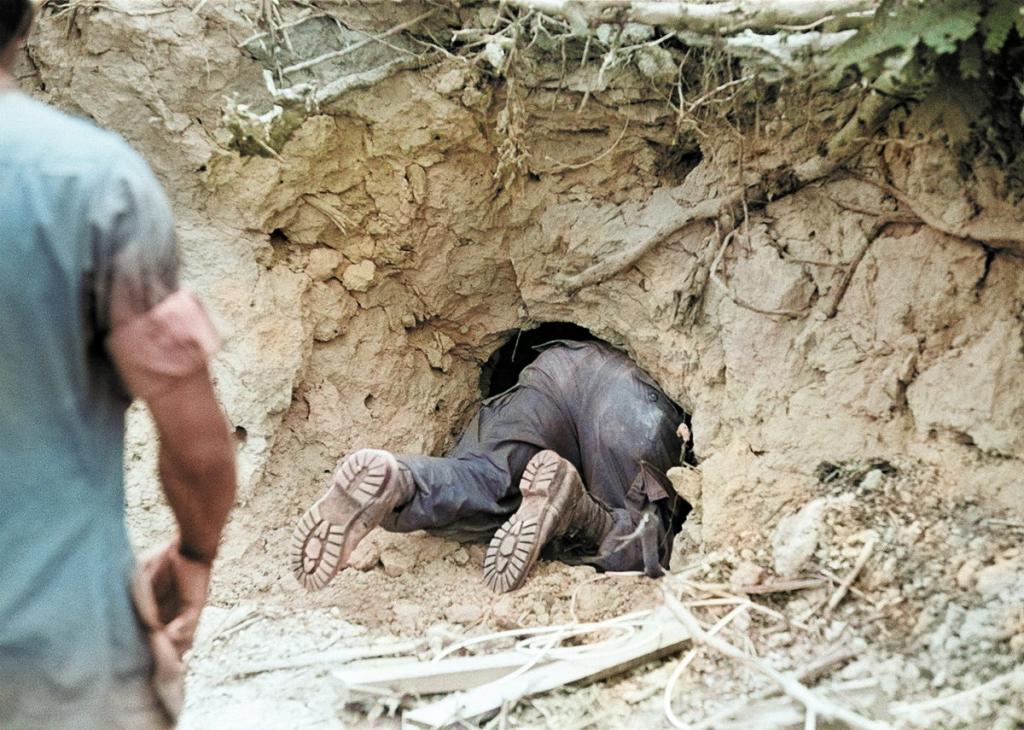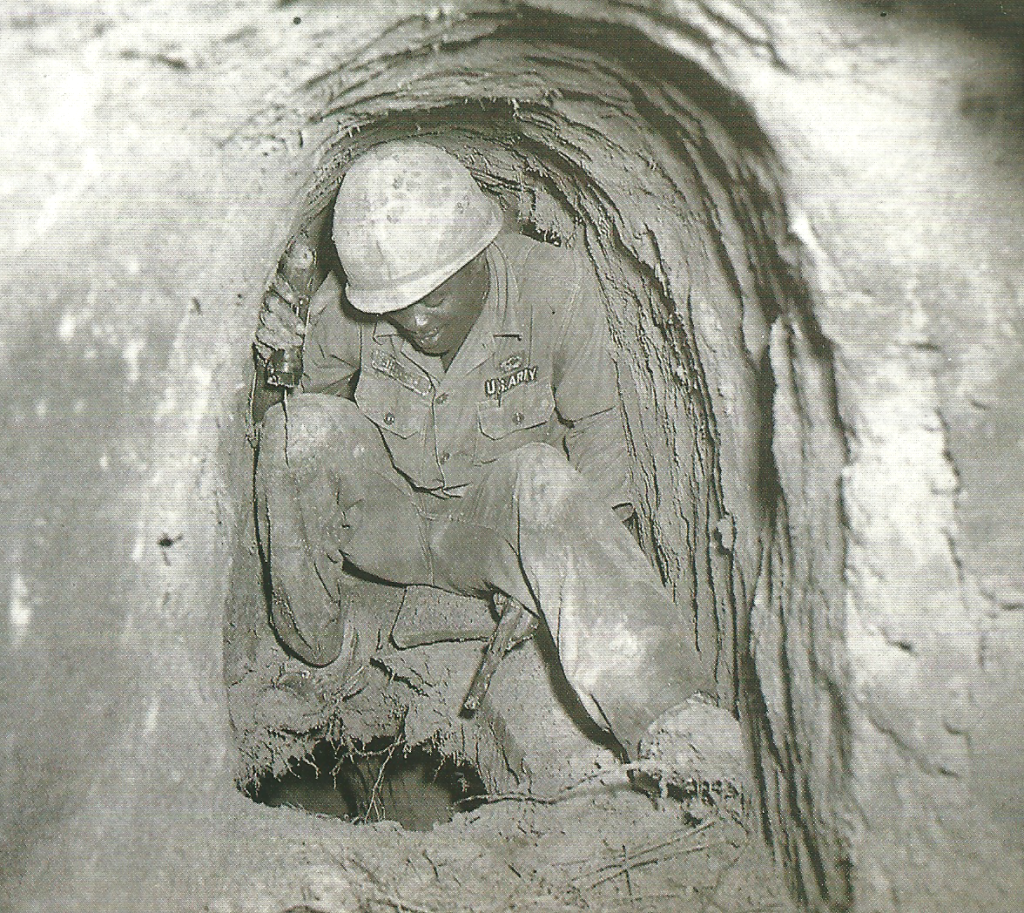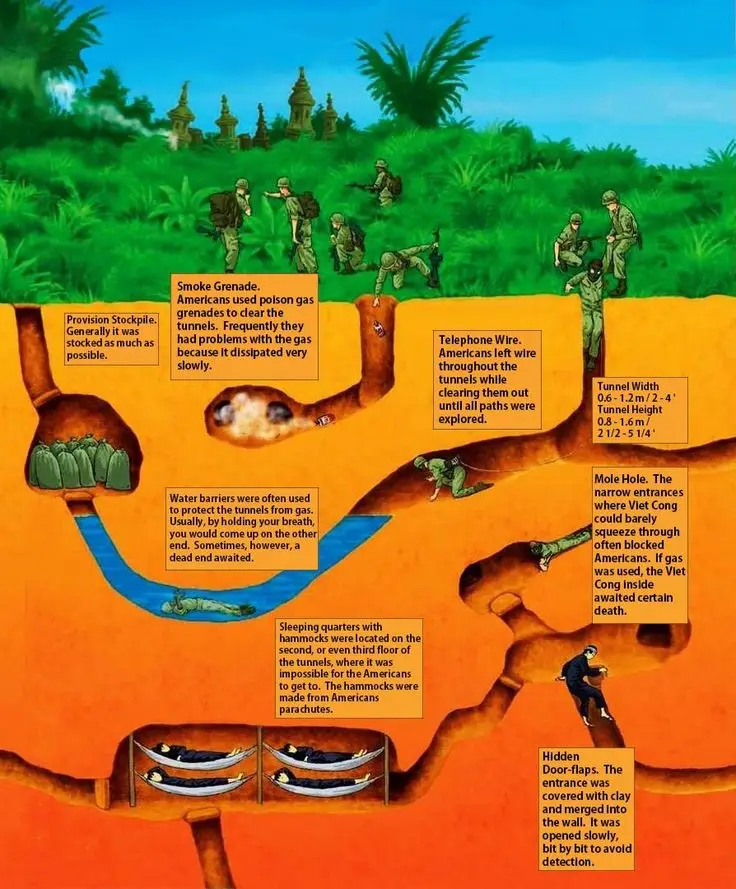Imagine crawling on your belly through a pitch-black, claustrophobic tunnel barely wider than your shoulders. The air reeks of mould, human waste, and death. Your only light is a flickering flashlight, and your only weapon is a small knife.
Somewhere ahead, a venomous snake might be coiled in the shadows; a tripwire could trigger a grenade, or an enemy soldier might be waiting to slit your throat.
This was daily life for the Vietnam War’s Tunnel Rats—the soldiers who volunteered to clear the Viet Cong’s labyrinth of underground fortifications. Their job was so perilous, so psychologically shattering, that many considered it a suicide mission.
In this article, we’ll talk about seven reasons why being a “Tunnel Rat” in Vietnam was so dangerous.
What were the Vietnamese Tunnels Like?

Following the fight against colonial forces, the Vietnamese improved their underground tunnel network. Initially just a few kilometres with a simple hideout design, it grew into over 160 miles of a huge tunnel network that could house people for months.
These weren’t just crude holes—they included hospitals, armouries, kitchens, and command centres, some three levels deep.
To put this in perspective, it will take a car traveling at 40 miles per hour more than 4 hours to cover the length of these tunnels.
Why Tunnel Rats Were Used in the Vietnam War

At first, the Americans, New Zealand, Australians, and South Vietnamese attempted to destroy the tunnels from outside, but it wasn’t so effective.
One of the things they tried was to pump poisonous gas into these tunnels to suffocate those in it. This did not work. The tunnels were designed with openings at various hidden locations. There were also pools at strategic locations in the tunnels to block any poisonous gas.
Dropping explosives into the tunnels didn’t work as well because the tunnels were not straight structures. They were designed with many bends that hindered the reach of explosives.
For the Americans, the most effective way to clear out the Vietnamese tunnels was to send in tunnel rats — soldiers who would crawl deep into the tunnels with a gun and explosives to spot and destroy the Viet Chong and their resources.
So what actually made the work of the American “Tunnel Rats” so dangerous?
1. The Tunnels Were Rigged with Bobby Traps
The Viet Chong were not stupid. They knew the United States military would come after them in these tunnels, and they planned for it.
The tunnels were laced with a series of deadly traps that were designed to maim, kill and traumatise any American that dared to enter into it. Some of these deadly traps include;
Snake boxes
These boxes were installed on the roof of the tunnels and filled with venomous and angry snakes. These boxes were designed with a trigger installed on the tunnel floor. Once triggered, the contents of the boxes were released, and any soldier within the distance was viciously attacked.
“Bouncing Betty” Mines
These mines featured tripwires that were rigged to launch grenades upwards and turn the tunnels into shrapnel-filed death tubes.
Punji Pitfalls
The Punji pitfalls were concealed pits lined with razor-sharp bamboo spikes. These spikes were also covered with human excrement to cause infection.
2. Tight Space And Tunnel Collapse

The Vietnam tunnels were only about 2 feet wide and 3 feet tall. It was impossible to walk in the passages, so soldiers had to crawl for hours on their bellies.
Although most tunnel rats were equipped with flashlights, these were sparingly used to avoid giving away positions to the enemy. Soldiers resorted to travelling in complete darkness and complete silence to increase their chances of survival.
It was so traumatic that most soldiers who made the journey developed psychological traumas afterwards.
The Tunnel rats also lived in constant fear of tunnel collapse. Such disasters sentenced any soldier trapped to a slow, long, and agonising death in the darkness.
3. Poor Ventilation and Suffocating Heat

Most trips into the Chu Chi tunnels were done at night, but even with this precaution, high temperature was something the American soldiers had to deal with.
Unlike the Vietnamese, these US tunnel rats were not prepared to deal with the temperature, which could be as high as 100°F on some days.
This high temperature, coupled with the dangerously low oxygen levels, caused many soldiers to pass out from heat stroke or suffocation in the tunnels.
4. Brutal Hand To Hand Combat.
Engagement with the enemy in the tunnels was primal, chaotic and horrifically personal. Although the tunnel rats were equipped with pistols, firing one risked deafening the shooter or collapsing the fragile tunnels.
Many fights ended in brutal knife battles or strangulation where the rat could not even see who his attacker was.
The Viet Chong designed the tunnels with small hidden chambers where a Viet Chong could hide and ambush a rat at point-blank range with very little time for the American to prepare.
To make matters worse, the United States soldiers did not receive proper training in this type of warfare. The little training they got was based on the report of older tunnel rats. This lack of knowledge gave the Vietnamese an advantage during these battles.
5. No Backup or Escape Options

The small size of the Viet Chong Tunnels meant that Tunnel Rats had to go in small teams to avoid detection. This also meant that there was very little help. Once you entered the tunnels, you were pretty much on your own.
There was nowhere to run or hide if something went wrong in the tunnels. Sometimes, naive tunnel rats would make a wrong turn, get lost and end up in a dead end where they’d die a slow and claustrophobic death.
If a rat was unfortunate to get injured by one of the many booby traps prepared in the tunnels, rescue was nearly impossible. The soldier had to drag himself back to safety or bleed out in the dark.
Every mission into the tunnels was a high-risk, life-or-death scenario.
6. Psychological Trauma
As a tunnel rat, even if you could deal with the physical dangers of the Viet Chong tunnels, the psychological torment was a different battle on its own.
The tunnels teemed with vermin. Soldiers recounted rats gnawing on corpses—or crawling over their faces in the dark. Decomposing bodies, human waste, and stagnant water created a stench that clung to skin and uniforms for days.
Some soldiers had to be pulled out screaming and crying — suffering a severe mental breakdown.
The prolonged exposure to darkness and stress caused hallucinations, paranoia, and breakdowns. Up to 20 per cent of all the United States troops in Vietnam returned with Post Trunmatic Stress Disorders (PTSD)
After the war, tunnel rats were unable to enter into tight spaces like closets or elevators.
7. Health Problems from Agent Orange

Agent Orange was a harmful herbicide that leached into the soil during the war. Rat tunnels were exposed to it as they spent a lot of time crawling through the contaminated soil and breathing its bad air.
According to a report, Agent Orange can lead to serious diseases such as cancer and birth deformity. The Tinnel rats were also exposed to poisonous gas specially designed to damage the respiratory system and cause intense pain.
Tunnel Rats emerged coated in toxic chemicals from soil soaked in defoliants, leading to cancers and birth defects decades later.
Read Also:
7 Deadliest Snipers in Modern History
Weird Weapons of War That Failed.
Why Their Courage Still Haunts Us
The Tunnel Rats’ story isn’t just about war—it’s about humans pushing themselves to the edge of sanity for a cause. Of the 700+ soldiers who volunteered, many didn’t return. Others came back broken, their bravery buried in classified files or dismissed as “dirty work.”
But in the annals of military history, few roles demand the raw, visceral courage of a Tunnel Rat. As one veteran put it: “Down there, you weren’t fighting for God or country. You were fighting to see the sun again.”
Think you could handle the darkness? Share your thoughts on history’s most harrowing jobs in the comments—and don’t forget to breathe.
